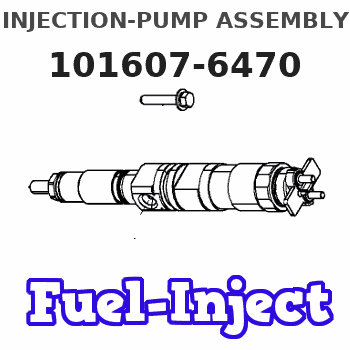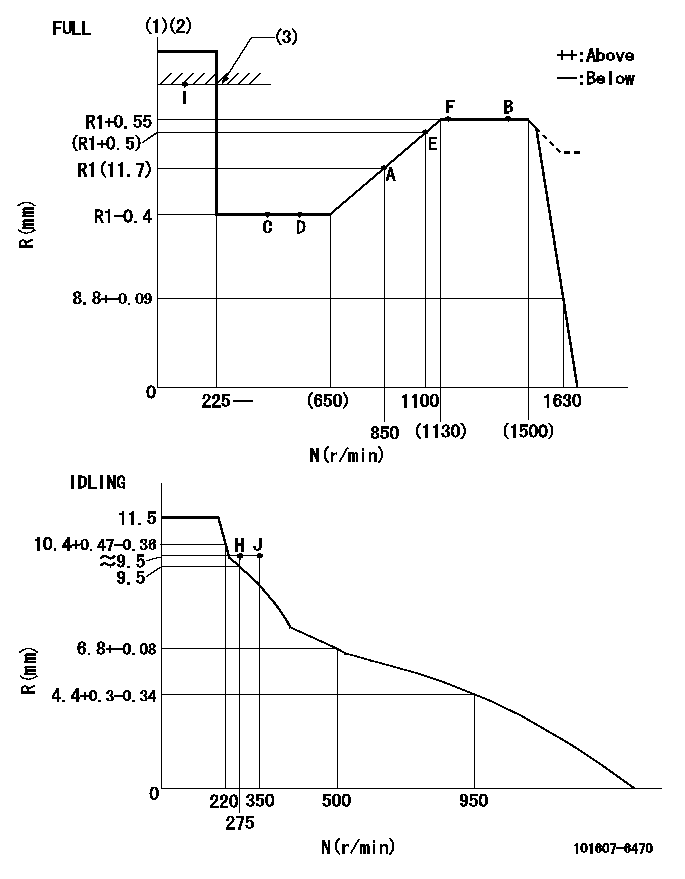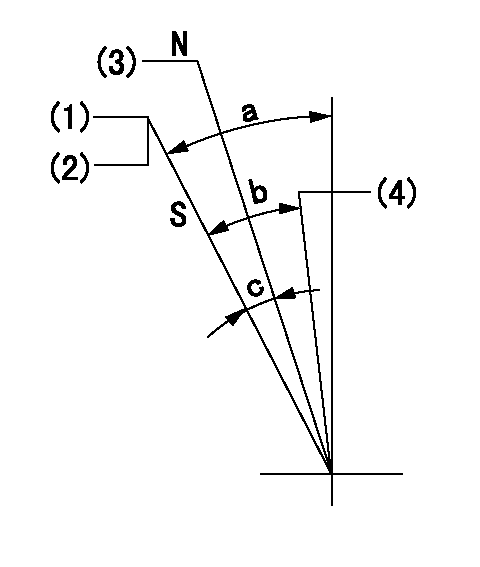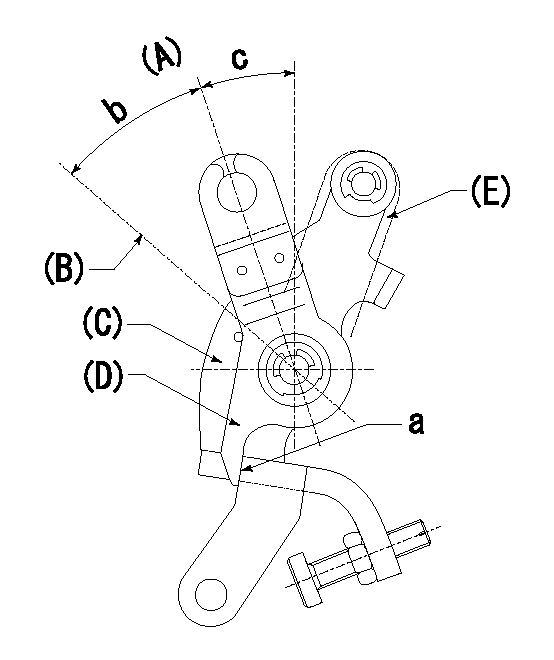Information injection-pump assembly
BOSCH
9 400 615 704
9400615704
ZEXEL
101607-6470
1016076470
MITSUBISHI
ME077801
me077801

Rating:
Service parts 101607-6470 INJECTION-PUMP ASSEMBLY:
1.
_
6.
COUPLING PLATE
7.
COUPLING PLATE
8.
_
9.
_
11.
Nozzle and Holder
ME076952
12.
Open Pre:MPa(Kqf/cm2)
15.7{160}/21.6{220}
14.
NOZZLE
Cross reference number
BOSCH
9 400 615 704
9400615704
ZEXEL
101607-6470
1016076470
MITSUBISHI
ME077801
me077801
Zexel num
Bosch num
Firm num
Name
101607-6470
9 400 615 704
ME077801 MITSUBISHI
INJECTION-PUMP ASSEMBLY
6D16 K 14BF INJECTION PUMP ASSY PE6AD PE
6D16 K 14BF INJECTION PUMP ASSY PE6AD PE
Calibration Data:
Adjustment conditions
Test oil
1404 Test oil ISO4113 or {SAEJ967d}
1404 Test oil ISO4113 or {SAEJ967d}
Test oil temperature
degC
40
40
45
Nozzle and nozzle holder
105780-8140
Bosch type code
EF8511/9A
Nozzle
105780-0000
Bosch type code
DN12SD12T
Nozzle holder
105780-2080
Bosch type code
EF8511/9
Opening pressure
MPa
17.2
Opening pressure
kgf/cm2
175
Injection pipe
Outer diameter - inner diameter - length (mm) mm 6-2-600
Outer diameter - inner diameter - length (mm) mm 6-2-600
Overflow valve
131424-8420
Overflow valve opening pressure
kPa
255
221
289
Overflow valve opening pressure
kgf/cm2
2.6
2.25
2.95
Tester oil delivery pressure
kPa
157
157
157
Tester oil delivery pressure
kgf/cm2
1.6
1.6
1.6
Direction of rotation (viewed from drive side)
Left L
Left L
Injection timing adjustment
Direction of rotation (viewed from drive side)
Left L
Left L
Injection order
1-5-3-6-
2-4
Pre-stroke
mm
3.2
3.15
3.25
Beginning of injection position
Governor side NO.1
Governor side NO.1
Difference between angles 1
Cal 1-5 deg. 60 59.5 60.5
Cal 1-5 deg. 60 59.5 60.5
Difference between angles 2
Cal 1-3 deg. 120 119.5 120.5
Cal 1-3 deg. 120 119.5 120.5
Difference between angles 3
Cal 1-6 deg. 180 179.5 180.5
Cal 1-6 deg. 180 179.5 180.5
Difference between angles 4
Cyl.1-2 deg. 240 239.5 240.5
Cyl.1-2 deg. 240 239.5 240.5
Difference between angles 5
Cal 1-4 deg. 300 299.5 300.5
Cal 1-4 deg. 300 299.5 300.5
Injection quantity adjustment
Adjusting point
-
Rack position
11.7
Pump speed
r/min
850
850
850
Each cylinder's injection qty
mm3/st.
77.4
75.1
79.7
Basic
*
Fixing the rack
*
Standard for adjustment of the maximum variation between cylinders
*
Injection quantity adjustment_02
Adjusting point
Z
Rack position
9.5+-0.5
Pump speed
r/min
800
800
800
Each cylinder's injection qty
mm3/st.
10.8
9.2
12.4
Fixing the rack
*
Standard for adjustment of the maximum variation between cylinders
*
Injection quantity adjustment_03
Adjusting point
A
Rack position
R1(11.7)
Pump speed
r/min
850
850
850
Average injection quantity
mm3/st.
77.4
76.4
78.4
Basic
*
Fixing the lever
*
Injection quantity adjustment_04
Adjusting point
B
Rack position
R1+0.55
Pump speed
r/min
1450
1450
1450
Average injection quantity
mm3/st.
87.7
83.7
91.7
Fixing the lever
*
Injection quantity adjustment_05
Adjusting point
C
Rack position
R1-0.4
Pump speed
r/min
500
500
500
Average injection quantity
mm3/st.
56
52
60
Fixing the lever
*
Injection quantity adjustment_06
Adjusting point
E
Rack position
(R1+0.5)
Pump speed
r/min
1100
1100
1100
Average injection quantity
mm3/st.
87.6
83.6
91.6
Fixing the lever
*
Injection quantity adjustment_07
Adjusting point
I
Rack position
-
Pump speed
r/min
100
100
100
Average injection quantity
mm3/st.
91
81
101
Fixing the lever
*
Rack limit
*
Timer adjustment
Pump speed
r/min
1150--
Advance angle
deg.
0
0
0
Remarks
Start
Start
Timer adjustment_02
Pump speed
r/min
1100
Advance angle
deg.
0.5
Timer adjustment_03
Pump speed
r/min
1450
Advance angle
deg.
6
5.5
6.5
Remarks
Finish
Finish
Test data Ex:
Governor adjustment

N:Pump speed
R:Rack position (mm)
(1)Torque cam stamping: T1
(2)Tolerance for racks not indicated: +-0.05mm.
(3)RACK LIMIT
----------
T1=H51
----------
----------
T1=H51
----------
Speed control lever angle

F:Full speed
I:Idle
(1)Stopper bolt set position 'H'
----------
----------
a=24deg+-5deg b=(46deg)+-3deg
----------
----------
a=24deg+-5deg b=(46deg)+-3deg
Stop lever angle

N:Engine manufacturer's normal use
S:Stop the pump.
(1)Set the stopper bolt at pump speed = aa and rack position = bb (non-injection rack position). Confirm non-injection.
(2)After setting the stopper bolt, confirm non-injection at speed cc. Rack position = dd (non-injection rack position).
(3)Rack position = approximately ee.
(4)Free (at delivery)
----------
aa=1450r/min bb=7.2-0.5mm cc=275r/min dd=(8.8)mm ee=15mm
----------
a=36.5deg+-5deg b=(25deg) c=13deg+-5deg
----------
aa=1450r/min bb=7.2-0.5mm cc=275r/min dd=(8.8)mm ee=15mm
----------
a=36.5deg+-5deg b=(25deg) c=13deg+-5deg
0000001501 LEVER

(A) Idle
(B) Full speed
(C) Base lever
(D) Accelerator lever
(E) Accelerator lever delivery position
1. Measure speed lever angle
(1)Measure the angle when the accelerator lever (D) contacted the base lever (C) at a.
----------
----------
b=(46deg)+-3deg c=24deg+-5deg
----------
----------
b=(46deg)+-3deg c=24deg+-5deg
Timing setting

(1)Pump vertical direction
(2)Position of timer's tooth at No 1 cylinder's beginning of injection
(3)B.T.D.C.: aa
(4)-
----------
aa=10deg
----------
a=(2deg)
----------
aa=10deg
----------
a=(2deg)
Information:
The current API categories represent the minimum requirements for diesel engine oils. These categories are developed in collaboration of OEMs and the Oil and Chemical industries.The current licensed oils are:
API CK-4, released December 2016
API CJ-4, released 2006
API CI-4, API CI-4PLUS released 2002
API CH-4, released 1998Each API category is technically more advanced and of higher performance than the prior one.Refer to API 1509 document and/or ASTM D4485 for details of the API tests requirements and limits.Note: Obsolete API oil categories are not licensed by the API and hence are of uncontrolled quality. These oils are technically inferior to current oils and can result in reduced engine performance and life. These obsolete oil categories are not allowed in Cat engines.API FA-4 is NOT recommended for Caterpillar engines. API FA oil is designed with low High Temperature High Shear (HTHS) viscosity oil for use in certain 2017 On-Highway truck engines that have to meet certain on-road emissions regulations. This category is not backwards compatible.In order to help protect your engine, and in order to help optimize oil drain intervals for engine applications and duty cycles, use Cat S O S Services oil analysis. Refer to the section below and to the section on Cat S O S Services given later in the Special Publication.
Depending on application severity and localized environmental conditions, and also depending on maintenance practices, operating Direct Injection (DI) diesel engines and operating PC (Precombustion Chamber) diesel engines on fuel with sulfur levels over 0.1 percent (1000 ppm) may require significantly shortened oil change intervals in order to help maintain adequate wear protection. Refer to this Special Publication, "Fuel Specifications" section, “Diesel Fuel Sulfur” topic for additional information.
Fuel Sulfur Impact on Engine Oil
The use of Cat S O S Services oil analysis is recommended for determining oil life.For Caterpillar machines operating under emissions regulations such as US EPA Tier4, EU Stage V or other emission regulations controls, the maximum fuel sulfur level permitted by regulations in the US is 0.0015% or 15 ppm. Maximum permitted fuel sulfur levels in other emissions regulated countries may vary from .0015% or 15 ppm slightly and must be followed.In order to help protect your engine and optimize oil drain intervals for engine applications and duty cycles, it is important to use SOS Services oil analysis to determine if the sulfur has degraded the oil. Use Cat S O S Services oil analysis per the following general guidelines:
Recommended normally
For fuel sulfur level up to 0.05 percent (500 ppm), no additional sampling is required. Follow the recommended oil sampling in the machine OMM
For fuel sulfur level of > 0.05 percent to 0.5 percent (500 ppm to 5000 ppm), SOS services oil analysis is strongly recommended to determine oil drain intervals. Sample the oil every 250 hours until a trend is established,
API CK-4, released December 2016
API CJ-4, released 2006
API CI-4, API CI-4PLUS released 2002
API CH-4, released 1998Each API category is technically more advanced and of higher performance than the prior one.Refer to API 1509 document and/or ASTM D4485 for details of the API tests requirements and limits.Note: Obsolete API oil categories are not licensed by the API and hence are of uncontrolled quality. These oils are technically inferior to current oils and can result in reduced engine performance and life. These obsolete oil categories are not allowed in Cat engines.API FA-4 is NOT recommended for Caterpillar engines. API FA oil is designed with low High Temperature High Shear (HTHS) viscosity oil for use in certain 2017 On-Highway truck engines that have to meet certain on-road emissions regulations. This category is not backwards compatible.In order to help protect your engine, and in order to help optimize oil drain intervals for engine applications and duty cycles, use Cat S O S Services oil analysis. Refer to the section below and to the section on Cat S O S Services given later in the Special Publication.
Depending on application severity and localized environmental conditions, and also depending on maintenance practices, operating Direct Injection (DI) diesel engines and operating PC (Precombustion Chamber) diesel engines on fuel with sulfur levels over 0.1 percent (1000 ppm) may require significantly shortened oil change intervals in order to help maintain adequate wear protection. Refer to this Special Publication, "Fuel Specifications" section, “Diesel Fuel Sulfur” topic for additional information.
Fuel Sulfur Impact on Engine Oil
The use of Cat S O S Services oil analysis is recommended for determining oil life.For Caterpillar machines operating under emissions regulations such as US EPA Tier4, EU Stage V or other emission regulations controls, the maximum fuel sulfur level permitted by regulations in the US is 0.0015% or 15 ppm. Maximum permitted fuel sulfur levels in other emissions regulated countries may vary from .0015% or 15 ppm slightly and must be followed.In order to help protect your engine and optimize oil drain intervals for engine applications and duty cycles, it is important to use SOS Services oil analysis to determine if the sulfur has degraded the oil. Use Cat S O S Services oil analysis per the following general guidelines:
Recommended normally
For fuel sulfur level up to 0.05 percent (500 ppm), no additional sampling is required. Follow the recommended oil sampling in the machine OMM
For fuel sulfur level of > 0.05 percent to 0.5 percent (500 ppm to 5000 ppm), SOS services oil analysis is strongly recommended to determine oil drain intervals. Sample the oil every 250 hours until a trend is established,
Have questions with 101607-6470?
Group cross 101607-6470 ZEXEL
Mitsubishi
Mitsubishi
Mitsubishi
101607-6470
9 400 615 704
ME077801
INJECTION-PUMP ASSEMBLY
6D16
6D16